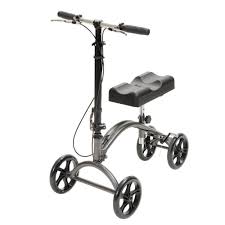If you had to choose between using a knee walker versus using crutches after recovering from a broken ankle, foot surgery, or any other operation or injury, you might wish you had the option to choose neither. After all, any assistive mobility device is going to be something that you’re going to have to learn to control and maneuver, not to mention drag around. Of course, choosing neither is an option if you have the time and ability to stay completely off your feet for an extended period of time. However, most people want and need to be able to get around, and the thought of being totally immobilized until well enough to walk unassisted is far from a pleasant thought.
And so, these two devices are really your best choices. Let’s consider their pros and cons:
• Crutches – the Pros: If you have decent upper body strength and mobility, you can usually walk faster with crutches, once you’ve figured out how to use them. Also, walking with crutches will certainly take some work, and there’s nothing wrong with getting some exercise when recuperating from an operation or injury. Also, crutches are fairly inexpensive. You can even rent them from a medical supplier.
• Crutches – the Cons: Crutches can be difficult to maneuver. And because all your weight must be carried on your armpits, you certainly risk irritating them – not to mention the wear and tear on your shoulders, wrists and lower back. Many people with injured legs find crutches too unsteady and unsafe for their use. Also, when your arms and hands are occupied clutching your crutches, you will have more difficulty in using them to open doors, pick things up, etc. Stairs can be particularly difficult to navigate with crutches, especially at the beginning. Finally, crutches are clunky items that are constantly falling over and don’t always fit through doorways, car doors, etc.
• Knee Walkers – the Pros: Knee walkers, because they are low to the floor are generally more stable than crutches. They are cushioned for comfort with space to let you rest a cast or injured leg, without having to put your weight on it. You can zoom around pretty quickly, once you get the steering figured out, and once you stop, you have both hands free. They are fairly simple to use and don’t require any upper body strength. They are less clunky than crutches and the possibility of slipping on slick or wet surfaces is diminished.
• Knee Walkers – the Cons: Knee walkers can be unstable if you lean back or forward too far or too much to one side. Also, they take a while to learn how to go straight. They are slower going than crutches on many surfaces. You cannot go up or down stairs on a knee walker, and if the front wheel base is too wide, you may not be able to go through narrow doorways or halls. Knee walkers are more expensive than crutches.
At Pacific Mobility, we can help you choose the best option for your post-operative or post-injury recovery. We will only sell you what you need, and within your budget, to help you get back on your feet in the quickest time possible. Call us today for a free consultation.
President, Husband, Father, Grandfather Graduate of UC Davis- Bio Sci Major- Go Aggies! Jeff has extensive experience in all of Pacific Mobility’s products and services, and specializes in accessibility products as well as stairlifts, ceiling lifts and custom wheel chairs. His hobbies include spending time with family, gardening, mountain biking, exercising and off road motorcycle riding.
24 years as Owner/President of Pacific Mobility Center – selling, installing, and servicing stairlifts, porch lifts, ceiling lifts, pool lifts, handicap ramping, specialty wheelchairs, scooters, power wheel chairs, and other power mobility devices
Certified Environmental Access Consultant since 2008
Licensed General Contractor since 1998
Certified Aging in Place Specialist since 2016
Board Member for Home Access Professionals
Member of Association of Members of the Accessibility Equipment Industry (AEMA)




